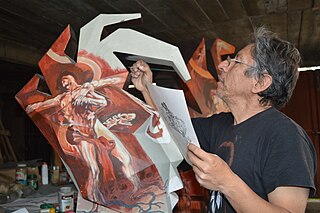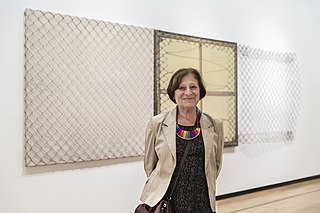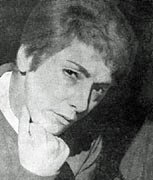Fernando Velázquez Vigil was a Cuban artist specialising in ceramics and painting.
Juana Lumerman was an Argentine visual artist who painted in both figurative and abstract styles.

Roberto Aizenberg, nicknamed "Bobby", was an Argentine painter and sculptor. He was considered the best-known orthodox surrealist painter in Argentina.

Manuel Espinosa was an Argentinian painter.

Mauricio García Vega is a Mexican painter whose work has been recognized by various awards and membership in the Salón de la Plástica Mexicana. His work is mostly focused on urban landscapes, often with dark themes and a chaotic feel. He works both alone and with his brother Antonio García Vega. He lives and works in the Mexico City suburb of Ciudad Nezahualcóyotl.

Adriana Lestido is an Argentine photographer. Her black-and-white photographs document the often difficult place of women in society.

Antonio García Vega is a Mexican artist and member of the Salón de la Plástica Mexicana. He began exhibiting his work while still in school in the early 1970s and continues to do so, often working with his brother Mauricio García Vega. He works in mixed media to paint various forms of expression. His early work was mostly fantastic, with elements of eroticism but his later work has been darker as a means of expressing his own feelings and moods. His work has mostly been exhibited in Mexico, often in conjunction with other artists including a 2010 exhibition with his brother at various venues.

Samy Mauricio Benmayor Benmayor is a Chilean painter who formed part of the Generation of '80 movement.
Carlos Eduardo Maturana Piña, better known by his artistic pseudonym Bororo, is Chilean artist born in Santiago, Chile, on November 10, 1953. Along with Samy Benmayor, Omar Gatica, Matías Pinto D'Aguiar and Ismael Frigerio among others, he formed part of Chilean art’s 80s Generation. Bororo was his childhood nickname.

Atilio Malinverno was an Argentine painter. He was a post-Impressionist, a part of a movement started in the first year of the 20th century.

Rogelio Polesello was an Argentine painter, muralist and sculptor. He was best known for making Op art known in Latin America. He won two Konex Awards; one in 1982 and another in 2012. He was born in Buenos Aires.

Andrés Francisco Giles is an Argentine artist based in New York. He has exhibited internationally since 1999. Among the group exhibits he participated in, worthy of mention is the Okupa exhibit that took place at the ArteBA event in 2012.

Juan Nicolás Melé was an Argentine sculptor, painter, and art critic. Melé was a member of the Asociación Arte Concreto-Invención as well as co-founder of the Grupo Arte Nuevo.
Elbio Raúl Lozza was an Argentine painter, draughtsman, designer, journalist, and theorist who was part of the concrete art movement. He was part of the Asociación Arte Concreto-Invención. He was the founder of the Perceptivist group. He was granted the Platinum Konex Award in Visual Arts from Argentina in 1992.

Diana Dowek is an Argentine visual artist, known for one of her first series, denoting her engagement in human rights movements. Dowek also was a founder of the Association of Visual Artists of the Argentine Republic (AVARA) and is now a Vice President.

Laura Malosetti Costa is a Uruguayan-born Argentine social and cultural anthropologist, researcher, art historian, and essayist. She is also a curator of art exhibitions and the author of several books on Latin American art. She was recognized with the Konex Award in 2006 and 2016.

Alberto Nicasio was an Argentine artist (xylographer) and educator. He was a member of the Argentinian National Academy of Arts. A street in the city of Córdoba and a primary school in the province are named after him.

Noemí Di Benedetto (1930–2010) was an Argentine painter and visual artist with a long career. She formed part of the Informalism group in Argentina.
Silvia Rivas is an Argentine visual artist known for her multi-channel video installations. In Latin America she is considered a precursor in the area of expanded video. Her work is characterized by the crossing of materialities and technologies in which she uses both electronic devices and ancestral techniques. Her production is organized in thematic series of video installations, drawings, photographs or objects. Interested in revealing the metaphorical power of different materialities, she uses the electronic medium and the moving image to record stillness, the imminent and the subjective perception of time.

Augusto Ballerini was an Argentine painter of portraits, historical scenes and landscapes.















